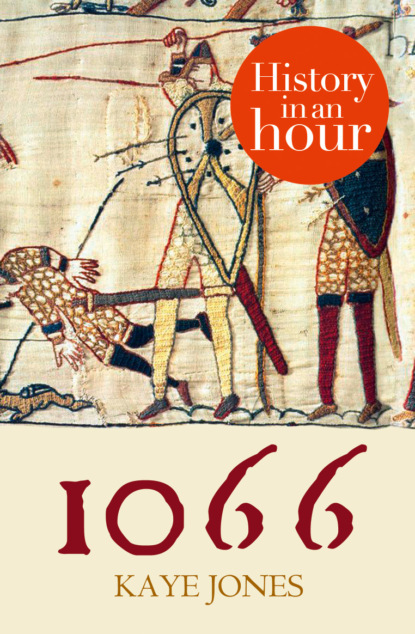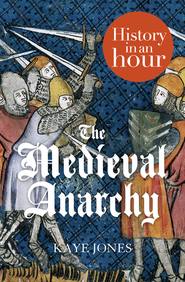По всем вопросам обращайтесь на: info@litportal.ru
(©) 2003-2024.
✖
1066: History in an Hour
Настройки чтения
Размер шрифта
Высота строк
Поля
February/March 1066: Developments Abroad
The news of Harold’s coronation reached Normandy very quickly and William did not take it well. He was furious that Harold had broken his promise and had himself crowned. Adamant that he was the rightful king of England, there was only one option left for the duke; assert his claim by force.
William, Duke of Normandy, as depicted on the Bayeux Tapestry
Knowing that he could not do it alone, he broached this idea to his magnates and received a mixed reception; some supported his desire to invade from the start, but others were going to need more convincing. According to the French writer, William of Poitiers, they believed that taking the throne of England in this way was an ‘arduous enterprise’ which went ‘well beyond the power of the Norman forces’.
Undeterred by the reaction of his magnates, William took his cause to the highest authority in Medieval Europe; the Pope. Fortunately for William, his embassy was successful and secured papal support for the invasion, including a banner for use in battle. This act of propaganda was immensely powerful; William now had God on his side and nobody would challenge his plans for an invasion. To sweeten his magnates, he promised enough supplies for the invasion and lands in England to all those who would join him. William had now set the wheels in motion; he was ready to bring England under Norman control.
April 1066: A Divine Omen?
At that time a star appeared in the north-west, its three-forked tail stretched far into the southern sky remaining visible for fifteen days; and it was portended, as many said, a change in some kingdom.
William of Jumieges
Halley’s Comet appeared in the skies above England on 24 April 1066 and was interpreted as an event of major significance. People believed that it was a divine symbol, a warning that dangers would soon threaten the kingdom. Nobody could predict how soon this danger would come, or in what form, but the English would not have to wait too long.
Tostig: A New Problem
Tostig Godwinson was Harold’s younger brother and, like the rest of his family, rose to become a prominent figure in English politics. As the earl of Northumbria, Tostig enjoyed great wealth and power over a vast area of northern England. But the situation changed in 1065 when a group of nobles rebelled against him with accusations of misrule and injustice. It became so serious that King Edward sent Harold to intervene. This had a significant impact on Tostig’s relationship with Harold, his brother, creating competition and driving a wedge between the two men.
In late 1065 Tostig’s earldom was confiscated and, after dismembering several of Harold’s servants and attempting to serve them up at a banquet, he was expelled from England. He was given refuge by his father-in-law, the count of Flanders and, sometime after his arrival in France, visited William in Normandy. The details of their meeting are unknown, but it appears that Tostig intended on forming an alliance with the duke and taking revenge on his brother Harold.
Unfortunately for Tostig, William had no interest in his plans for an alliance. The duke had already begun preparations for his forthcoming invasion and had gained the support of his noblemen and the Church. Tostig was, however, undeterred. In his attempts to muster support, he travelled north to rally King Swein of Denmark, and claimant to the English throne, King Harald Hardrada of Norway. Swein was quick to dismiss him but, in Hardrada, Tostig had found a sympathetic ear.
May 1066: Tostig Returns to England
Shortly after the appearance of Halley’s Comet, Tostig set out on a solo expedition to England and landed on the Isle of Wight. The islanders, probably very surprised by his presence, treated him in the same way as a Viking raider; they paid him off with food and money in the hope that he would leave. Within a few days he set off once again, this time landing at Thanet and meeting up with his friend and supporter, Copsi. While Tostig was the earl of Northumbria, Copsi had acted as his deputy, carrying out vital administrative functions and overseeing the general governing of the earldom. In 1065, Copsi was expelled from England alongside his lord, possibly accompanying him to Flanders, though the exact details are unknown. Contemporary writers, like Ordericus Vitalis and William of Poitiers, portrayed Copsi as an honest, faithful and loyal servant, ready to protect and advance the interests of his lord at a moment’s notice. Thus it is hardly surprising that Tostig turned to Copsi in his hour of need.
Halley’s Comet as depicted on the Bayeux Tapestry
In the face of an impending invasion, defending the realm was Harold’s main priority and he had recently assembled the Fyrd. The Fyrd were the king’s civilian militia; peasant farmers who could be called upon to fight for a maximum of two months per year. By May 1066, they were gathered along the south coast, waiting for a glimpse of William’s fleet. They must have been very shocked to see Tostig, the king’s brother, there instead.
Tostig Flees England
While Tostig lingered on the south coast, King Harold was in London. He wasted no time in marching south, through Kent, to confront his brother. By the time he reached the south, Tostig had fled with as many ships and men as he could muster. He probably intended to return to his wife in friendly Flanders, but owing to an unfavourable wind, was forced to sail north.
He landed at the Humber, on the east coast of England, but was quickly seen off by the northern earls, Edwin and Morcar, and so fled to Scotland where he sought refuge with King Malcolm.
June 1066: Harold’s Fleet is Ready
Although Harold had a fleet of 300–400 ships, he had no intention of fighting the Normans at sea. Eleventh-century navies were not used for battle, but rather to transport the army to wherever it was needed. By June 1066, Harold’s impressive fleet was based on the Isle of Wight, ready to move to wherever the Normans landed. Accompanied by his brothers, Gyrth and Leofwine, and with his army ready to mobilize, Harold probably felt confident in his ability to protect his crown and the people of England. But with no idea of when William might strike, Harold and his men were left to wait.
Over in Normandy, William’s invasion preparations kept him busy through the summer months. He had hired as many mercenaries as possible to ensure adequate manpower for the invasion and began building a fleet to carry his army over the English Channel. In early June, William ensured that Normandy would not face the same succession problems as England, by arranging for his son to succeed him should he not return from battle. On 18 June, he accompanied his wife, Matilda, to the dedication of the new abbey at Caen where he asked for God to bless his invasion of England.
The Norwegians
Then King Harald and the earl (Tostig) talked long and frequently together; and at last he took the resolution to proceed in the summer to England, and conquer the country.
Heimskringla (a collection of sagas about the Norse kings)
Soon after Tostig’s spring visit to Norway, King Harold Hardrada began planning his conquest of England. To provide the bulk of his army, he called on one-half of all men in the country who could carry arms. Harald received a similar reception to that of William in Normandy; some believed that England was too great a country to conquer, while others thought that Harald was the perfect man for the job. Either way, Harald was determined to go on with his plans and, by the summer of 1066, his fleet was stationed at the Solund, the westernmost tip of Norway.
Вы ознакомились с фрагментом книги.
Приобретайте полный текст книги у нашего партнера:
Приобретайте полный текст книги у нашего партнера:







